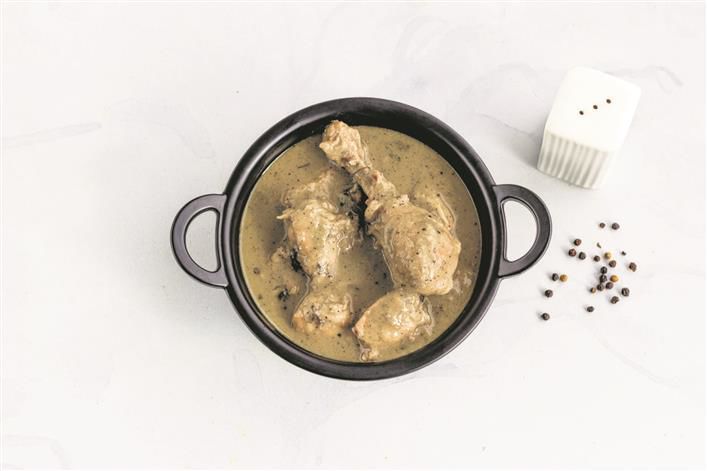Peppered with taste
Rahul Verma
A tall, wooden pepper mill makes quite a grand appearance when friends come home for a special meal. Like some of our top chefs, I twist its lower end vigorously over a dish that’s been plated — and the delicious aroma of freshly ground peppercorn fills the air.
Ingredients
- Chicken 1 kg
- (cut into small pieces)
- Curd 1½ cup
- Onion (medium) 1
- Garlic cloves 6
- Ginger 1-inch
- Green chillies 2
- Coriander powder 1 tsp
- Freshly ground 1 tbsp
- black pepper
- Green cardamoms 4
- Peppercorns 1 tsp
- Cinnamon stick 1
- Garam masala A pinch
- Salt To taste
- Oil For frying
Method
Chop the onion and mince the garlic and ginger. Blend these with coriander powder, ground black pepper and salt in a blender. Add chopped green chillies to this mix. Add this to the curd, and marinate the chicken in it. Keep it aside for 15 minutes. Heat the oil. Add whole spices and chicken. Fry for a few minutes, then add the marinade. Let it simmer, stirring every now and then. Add water, if the masalas stick to the pan. Once the chicken is done, add the garam masala. Before serving, sprinkle a teaspoon of freshly ground black pepper over it.
If there is a condiment that lends itself to all kinds of cuisines and dishes, it’s the peppercorn. You use it for dips, salads, soups and appetisers; for entrees; and dessert. And speaking of desserts, I still drool when I think of a sweet that street vendors used to sell once. It was a thin sheet of sugar dotted with peppercorns, and the two disparate tastes — sweet and hot — played a delightful duet together.
Pepper, as we know, is native to Kerala, and there is archaeological evidence of the use of pepper in India in 2000 BC. Called ‘maricha’ in Sanskrit, it has been referred to in ‘Arthashastra’. The ‘Mahabharata’ describes a feast in which meat was served “dressed in ghee, with sea salt and black pepper sprinkled over, and garnished with radishes, pomegranates, lemons, fragrant herbs, asafoetida and ginger”. But, to my mind, pepper does not need too many associates. Just a few peppercorns, or a bit of powdered pepper, can spice up any dish. Think of the otherwise bland boiled egg, and the simple mulligatawny — literally pepper-water — soup.
A great many dishes and drinks in India rely heavily on the use of pepper. Take rasam, in which pepper plays a lead role. Or take a cup of tea fortified with pepper, ginger and a few other ingredients — a remedy for sore throats and blocked noses. Try adding some pepper to your butter chicken. It will give new meaning to the old dish. Then, there’s a delicious Bengali potato dish called aloo morich, which is a simple dish of diced and boiled potatoes, sautéed in ghee, salt and powdered black pepper.
I remember a dish of kali mirch murg that I had in Haldwani on the foothills of the Kumaon hills, almost 30 years back. Our car had broken down, and when it went for repair, we spent our time trying out the food at the small roadside dhabas. It was there that I had Kallu’s pepper chicken — soft pieces of chicken in a thick sauce, heavily flavoured with pepper. I have often cooked a version of that at home, a recipe I share with you.
Some regions have their own varieties of peppers, too. Assam’s local bon jaluk, for instance, is quite a popular spice and gives a punch to shami kebabs and mutton kormas. Green peppercorn — the stage before the spice is dried — does wonders, too. A friend once gave me a recipe for chicken cooked with mushroom, cream, tomatoes and green peppercorn — it looked as good as it tasted. South India’s pachai milagu kuzhambu is another superb yet simple dish, prepared with green peppercorns, asafoetida, curry leaves, dry red chilies, tamarind and sesame oil. You will find white pepper — pepper where the black outer skin has been removed — in many Chinese dishes.
Pepper has many health benefits. But while I am grateful to it for helping us clear our throat and sinuses, I can’t thank it enough for its most treasured property — the magic that it wields in food.









